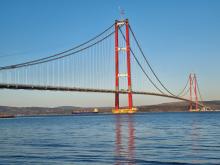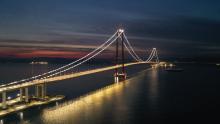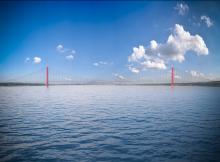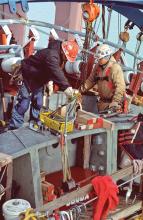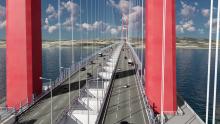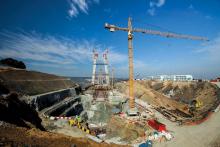The massive structure is highly imposing. The side spans of the bridge measure 770m apiece while the approach viaducts are 365m and 680m in length. Combining the approach viaducts, side spans and central span, the bridge has a total length of 4,608m. Meanwhile, the main cables are supported at a height of 318m by the dual towers. And the bridge deck features three lanes for vehicle traffic in either direction.
This huge construction project was extremely complex. But in spite of this, work progressed well and its construction took just four years to complete allowing the bridge to open 18 months ahead of schedule in March 2022.
This vital section of the 101km Malkara-Çanakkale Motorway, is itself part of Turkey’s Vision 2023 Master Plan and intended as part of a much wider national development programmme. The opening of the new bridge has reduce the crossing time for the Çanakkale Strait to just six minutes, considerably quicker than the ferry service that previously plied the route.
Building the 101km motorway connection has cost a total of €2.6 billion while the suspension bridge has cost €1.8 billion, around 68% of the total pricetag for the Malkara-Çanakkale Motorway.
The challenging nature of the Çanakkale region meant that the designers had to ensure the bridge could cope with high wind speeds. As a result an orthotropic, twin-box section steel deck was selected, featuring a 9m median gap and a total width of 45m. In total, this specially-designed steel deck is comprised of 153 segments.
The challenges posed by the wind and seismic loads were overcome through the use of state-of-the-art engineering expertise, real-time data, innovative design and collaborative teamwork. Seismic activity in the region, heavy ship traffic, strong wind conditions in the Çanakkale Strait, and high live loads posed significant challenges for the project. The seismic and aerodynamic designs necessitated innovative approaches for ship collision risk analysis and dynamic load modelling.
Extensive tests were carried out to ensure the bridge would behave well under high wind loads during the operational as well as the construction phases. A 1/60 scale model of the deck section was prepared as well as a 1/225 scale model of the free-standing tower and a 1/190 scale model of the whole bridge. The design of the sections was then validated through a series of tests to ensure the reliability of the structure even in the highest winds.
The Çanakkale region is also noted for its seismic activity, which was one of the reasons the suspension bridge design was selected, instead of a cable-stayed structure. To optimise stability against potential earthquake loads, the foundations for the towers utilise submerged caissons, which have been positioned carefully in an area strengthened with steel piles.
Once again, extensive testing has been carried out based on three different earthquake scenarios. These are the Functional Evaluation Earthquake (FEE), expected to recur in 145 years, the Safety Evaluation Earthquake (SEE) expected to recur within 975 years, and the Non-Collapse Earthquake (NCE) expected to recur within 2,475 years. In addition, for the massive earthquake shock expected to recur within 2,475 years, the design has been tested for "Minimal Damage Level" for its underwater caisson foundations. This has eliminated the need for repairs. The structure has also been tested for "Repairable Damage Level" for those structural elements above water, which has shown that repairs to the upperstructure will be feasible if needed.
From the perspectives of management and logistics, this was a momentous project that involved the collaboration on a global scale of over 1,300 subcontractors, suppliers, and consultants from 19 countries. Tasks that related to design requirements were assigned to COWI, based in Denmark. This was all carried out within the tight four-year project timeframe, including design, procurement, and construction, requiring effective design solutions to deliver the necessary progress.
In addition to the numerous technical challenges, unforeseen obstacles were presented by the COVID-19 pandemic. However, despite disruptions in the supply of materials sourced from other countries during times of pandemic-related restrictions, the work progressed smoothly and adhered to the schedule, ensuring that there were no interruptions in the construction process. Even during the first wave of the pandemic, stringent measures were implemented on-site, allowing the workforce of 2,600 to carry on with the project, without compromising worker safety.
Structurally speaking
The foundation of each tower caisson comprises a tie beam, plinth, composite shaft, caisson foundation, gravel bedding, and steel piles used for ground improvement. Before submerging each tower foundation caisson, ground improvement was carried out beneath the area where the foundation was to be located. Below the Asian tower foundation, there are 165 steel piles with diameters of 2.5m and lengths of 21.25m underneath the foundation for the tower on the Asian side. Meanwhile, there are 203 steel piles with diameters of 2.5m and lengths ranging from 40-46m installed underneath the foundation for the tower on the European side.
The 1915 Çanakkale Bridge has also been designed to the latest safety standards to be able to withstand impacts from shipping. This is of note following the recent collapse of the Francis Scott Bridge in the US following a collision by a large container vessel that had lost power.
The bridge’s two towers carry the loads from the deck, main cable, and suspension cables (along with other secondary dead loads) as well as the live traffic loads. These forces are transferred from the towers to the 74m x 83.3m caisson foundations located on the seabed. Each of the towers features two steel legs, which are themselves connected by three steel tie beams.
Meanwhile, the steel legs are made from 32 steel blocks while the tie beams connecting the legs are made from three steel blocks. In total, the two bridge towers are comprised of 128 steel blocks for the legs along with 18 steel blocks for the tie beams. The installation job for the upper crossbeams was extremely challenging as it required a heavy lift operation to raise the 155tonne components to a height of 318m.
The main cables for the main span have 144 steel strands while the cables in the side spans feature 148 steel strands. Each of these strands is itself made up of 127 wires with diameters of 5.75mm. Galvanised steel has been used for the wires to ensure protection against corrosion in the harsh environment, while these wires offer high tensile strength of 1,960MPa to cope with the mechanical loads. The total length of 162,000km of wires used in the main cables is equivalent to four times the circumference of The Earth, while the project used 227,000m³ of concrete and 177,000tonnes of steel.
Principle cast
The 1915 Çanakkale Bridge was constructed by a joint venture comprising the Turkish companies Limak and Yapı Merkezi, along with South Korean firms DL E&C and SK Ecoplant, while the bridge is now operated by Çanakkale Motorway and Bridge Construction Investment and Operation.
The design was carried out by COWI ( based in Denmark) and independently verified by ARUP-AAS Jakobsen. The investors in the project were DL E&C, Limak, SK Ecoplant, Yapı Merkezi.
The tender process and the administration for the project was managed by the Republic of Türkiye Ministry of Transport and Infrastructure, General Directorate of Highways (KGM). The consultants TEKFEN Engineering – T Engineering International SA operated as a joint venture for the work.
A symbolic structure
Many of the features of the bridge have symbolic significance. The length of the central span itself is of historic note, marking the 100th anniversary of the formation of the Republic of Türkiye, then headed by Kamal Ataturk. The steel bridge towers are painted red and white to symbolise Turkey’s national flag (as well as to assist conspicuity for aviation and shipping). Other aspects of the bridge also represent the country’s history.
The 318m height of the steel towers represent the date of the Çanakkale Victory in WWI on March 18th, 1915. The top shell figures placed on the 318m steel towers represent a cannonball, in reference to the Çanakkale War and the independence of the Turkish nation. With these, the total height of the towers reaches 334m. In addition, the motifs on the tie beams represent Turkish-Islamic designs while the viaduct piers symbolise the Çanakkale Martyrs Memorial.
Green is good
The bridge builders also ensured that strict environmental requirements were met. In addition to the local Environmental Impact Assessment (EIA), an Environmental and Social Impact Assessment (ESIA) was carried out to accepted international standards.
As part of the Environmental and Social Impact Assessment (ESIA), the research on marine life revealed that driving the piles needed for the bridge tower foundations could have negatively impacted upon certain dolphin species migrating through the Çanakkale Strait. However, necessary measures were implemented to mitigate this issue.
During the piling works on the seabed between March and November 2018, three expert Marine Mammal Observers were on duty 24/7. The observers carried out a preliminary assessment before the pile works and warned the construction team to halt the pile driving if dolphins approached within 500m during the pile installation. Pile works were stopped five times during this period due to dolphin crossings, with a total waiting time of over 2 hours for dolphin passages.
In addition, the Pinna Nobilis mussel species was identified as potentially being affected by the sea structures of the bridge. As this species is protected in the Mediterranean, a collaboration with Çanakkale 18 Mart University was initiated and in this study, more than 1,000 of the protected mollusk species were relocated to adjacent safe zones.
Accolades
The 1915 Çanakkale Bridge has received a total of 24 national and international prestigious awards so far, a testament to its innovative and groundbreaking design. However, the advances in design and construction that have permitted the construction of this landmark structure may well result in even longer central spans for suspension bridges. The 1915 Çanakkale Bridge could itself be surpassed should the plans by the Italian Government to connect the island of Sicily to mainland Italy be realised, after many stops and starts. The Italian bridge would take the design and construction of suspension bridges still further, featuring the highest cable support towers and longest central span yet conceived. The ultra-long central span is needed for the Italian bridge given the tempestuous nature of the Messina Strait, not to mention the significant volume of water traffic. However, this link to Sicily will be enormously costly to construct and while the current administration has pledged to build it, there are many who question the expense of the project. And until the construction work is complete for Italy’s proposed Messina Strait bridge, the 1915 Çanakkale Bridge will retain its title of having the longest central span of any suspension bridge in the world.
*Images provided courtesy of General Directorate of Highways Ministry of Transport and Infrastructure, Republic of Türkiye

